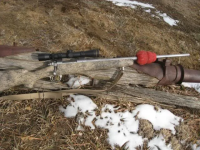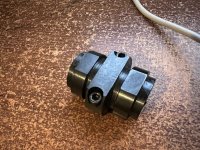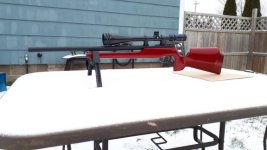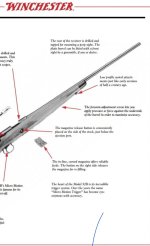So, I mentioned over here (clickable) that if we wanted to dig into what a mid-barrel tuner might be doing that perhaps we should start a new thread for that topic, so here we go. I wasn't really sure how to best approach this to try and figure out the physics of the matter to try to learn what they might be doing. I think I have a pretty good grasp of what is going on with tried and true muzzle tuners, but when it came to mid-barrel tuners I don't feel I had ever given them a whole lot of thought before now. Even trying to picture what they might be doing with regard to what the barrel is doing during the firing cycle seemed a bit difficult. I ended up writing a simplified simulation to try to get a handle on it. Here's what I've got so far.
So, I've now written a simulator that I can enter in a barrel length, diameter, bore diameter, as well as locations and amounts of added masses, tuners. I can add as many as I like anywhere. Be that at the muzzle, somewhere in the middle, or several at various locations. I'm sure it can get pretty complicated, but what I've looked at so far is a bare 660.4 mm / 26" barrel that's 25.4 / 1" in diameter, and with a 5.66 mm / 0.223" bore. My old Harrell tuner weighs 252 g / 8.9 ounces. With it set at 0 clicks this seems to put its centre of gravity out at 682.1 mm, and at 500 clicks at 689 mm. Now, this is a bit simplified because we aren't taking into account the mass and CoG for the stock, or the action, scope bases, and scope. They would all matter, too, but just for the sake of comparison I think it is fair to ignore them. I don't think we'd be putting time to good use trying to get any more complicated without also figuring out just exactly how much energy is being imparted and how to time that properly, not to mention the effect of the bullet travelling down the bore, and on and on and on. It gets complicated rather quickly, and this is already fairly complicated.
Now, according to Geoffrey Kolbe's data (clickable) the bullets seem to exit somewhere in the 2.0-2.5 milliseconds region once the firing has commenced. Given the variables that are missing here, I'm not sure it is fair to say that we can also map our theoretical bullet exits to the same region of these graphs. I don't think that's terribly important for the sake of trying to learn how the mid-barrel tuners are affecting things anyway. I think the most important thing to focus on is just what exactly is happening to the shapes of the muzzle traces. Here we can see a comparison between the muzzle traces for the bare barrel, as well as with the Harrell tuner installed at 0 clicks, and also at 500 clicks.
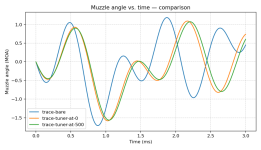
Comparing to the blue trace for the bare barrel we can see that the tuner at 0 clicks is basically just making things happen more slowly. The curve looks largely the same, and is more or less just stretched out to the right to indicate that things are taking longer to happen. But the same general things are happening. So it is making all the frequencies involved a bit lower, so stretched out to the right, and at a slightly lower amplitude, so peaks and valleys are a bit smaller. The important thing being, the overall shape isn't really changing all that much. It's just taking slightly longer to do the same things, and it is slightly muted. Now, here's the bare barrel, and the Harrell at 0 clicks, and the 161 g / 5.7 ounce mid-barrel tuner installed at the 431.8 mm mark. There's nothing special about that spot. It's just 4" ahead of the middle, and chosen simply because it made a good visual example.
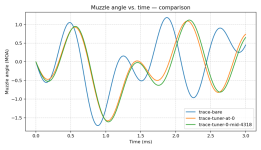
It is making things happen at a slightly slower rate than with the Harrell alone, but it is also doing something else. It is slightly changing the shape of the trace as time goes by. It isn't merely slowing down and getting muted now. Now it is also possible to change the amplitude of the different peaks and valleys individually, sort of. You can see the third valley right around the 1.75-millisecond mark is lower than both the bare barrel and with the Harrell. The following peak is hgher than the Harrell, too. So in that case it is increasing the amplitude of that upswing. Here's another comparison of three different mid-barrel locations. 330.2 mm, 431.8 mm again, and 558.8 mm, or 4" increments.
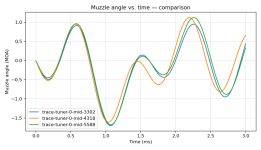
I picked these increments because I thought it did a good job of showing how the spot selection for the mid-barrel tuner can actually speed some things up. Here the 330.2 mm and 558.8 mm traces are both noticeably slower than the 431.8 mm trace once it gets past the 0.5 ms mark. And it highlights again how both the amplitudes and timings are being affected. This is a little busy, but here are 1" increments from the halfway point on up, as well as the first three without the mid-barrel tuner.
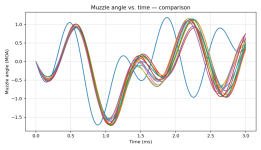
While it is tough to see all the individual lines now, one thing it does make clear is how much you can affect the rising portion between about 1.75 and 2.25 milliseconds. The angle of that upswing relates to the launch angle requirements for different muzzle velocities and a given distance. There's an optimal upswing angle for a given distance. If you look at the last graph in Kolbe's article you can see a green line representing the optimal upswing angle, 6 MOA/ms, for 50 metres.
I don't know how much work it would be, but adding a few more variables to this simulator might not be very trivial to do. If I could figure out how to take into account the stock, action, rings, scope, and all of their respective CoGs and how all of that affects the entire system, and on top of that figure out actual proper bullet exit timing (jeez, and also how the bullet itself affects all of that) then it would be a simple matter to design barrels and matching tuners that shoot best at any given distance. hahahaha, oh yeah, just that simple. Heheh. Anyway, it wouldn't be impossible, but holy cow, I think it would be an insane amount of work compared to what I threw together just to do this simple straight-barrel-only comparison. This was a bit of effort to get working as-is, but I think to get even more complicated than this it would probably be better at that point to just draw up models of everything and feed it into a finite element analysis software and let it do the simulating. That's what they're made for anyway, heh. But for just the barrel by itself, I think this was quicker to do, even though it wasn't all that quick.
hahahaha, oh yeah, just that simple. Heheh. Anyway, it wouldn't be impossible, but holy cow, I think it would be an insane amount of work compared to what I threw together just to do this simple straight-barrel-only comparison. This was a bit of effort to get working as-is, but I think to get even more complicated than this it would probably be better at that point to just draw up models of everything and feed it into a finite element analysis software and let it do the simulating. That's what they're made for anyway, heh. But for just the barrel by itself, I think this was quicker to do, even though it wasn't all that quick.
edit: Oh yeah, I forgot! I also meant to post the frequencies for the first four modes for the bare barrel, with the Harrell installed, and then with the mid-barrel at all of those distances. Just for the sake of curiosity. I don't think they're really all that usable for anything, but it does at least give an idea of how the different locations affect the frequencies. This will be due to the physical relation between the mid-barrel tuner and the actual vibration cycle of the first four harmonics. When you're placing it at/near a node or antinode this is how it affects things from a frequency perspective. Another indication of how things don't simply slow down. The 1st mode certainly does at each step, since there we're only talking about what is happening right at the muzzle. But the other modes show different behaviour depending on where the mid-barrel tuner is in relation to that mode's nodes and antinodes. The green to white to red shading for each row indicates highest to to mid to lowest frequencies for that mode, and you can see that only the first mode follows that left to right. The others stray from that due to placement.

So, I've now written a simulator that I can enter in a barrel length, diameter, bore diameter, as well as locations and amounts of added masses, tuners. I can add as many as I like anywhere. Be that at the muzzle, somewhere in the middle, or several at various locations. I'm sure it can get pretty complicated, but what I've looked at so far is a bare 660.4 mm / 26" barrel that's 25.4 / 1" in diameter, and with a 5.66 mm / 0.223" bore. My old Harrell tuner weighs 252 g / 8.9 ounces. With it set at 0 clicks this seems to put its centre of gravity out at 682.1 mm, and at 500 clicks at 689 mm. Now, this is a bit simplified because we aren't taking into account the mass and CoG for the stock, or the action, scope bases, and scope. They would all matter, too, but just for the sake of comparison I think it is fair to ignore them. I don't think we'd be putting time to good use trying to get any more complicated without also figuring out just exactly how much energy is being imparted and how to time that properly, not to mention the effect of the bullet travelling down the bore, and on and on and on. It gets complicated rather quickly, and this is already fairly complicated.
Now, according to Geoffrey Kolbe's data (clickable) the bullets seem to exit somewhere in the 2.0-2.5 milliseconds region once the firing has commenced. Given the variables that are missing here, I'm not sure it is fair to say that we can also map our theoretical bullet exits to the same region of these graphs. I don't think that's terribly important for the sake of trying to learn how the mid-barrel tuners are affecting things anyway. I think the most important thing to focus on is just what exactly is happening to the shapes of the muzzle traces. Here we can see a comparison between the muzzle traces for the bare barrel, as well as with the Harrell tuner installed at 0 clicks, and also at 500 clicks.

Comparing to the blue trace for the bare barrel we can see that the tuner at 0 clicks is basically just making things happen more slowly. The curve looks largely the same, and is more or less just stretched out to the right to indicate that things are taking longer to happen. But the same general things are happening. So it is making all the frequencies involved a bit lower, so stretched out to the right, and at a slightly lower amplitude, so peaks and valleys are a bit smaller. The important thing being, the overall shape isn't really changing all that much. It's just taking slightly longer to do the same things, and it is slightly muted. Now, here's the bare barrel, and the Harrell at 0 clicks, and the 161 g / 5.7 ounce mid-barrel tuner installed at the 431.8 mm mark. There's nothing special about that spot. It's just 4" ahead of the middle, and chosen simply because it made a good visual example.

It is making things happen at a slightly slower rate than with the Harrell alone, but it is also doing something else. It is slightly changing the shape of the trace as time goes by. It isn't merely slowing down and getting muted now. Now it is also possible to change the amplitude of the different peaks and valleys individually, sort of. You can see the third valley right around the 1.75-millisecond mark is lower than both the bare barrel and with the Harrell. The following peak is hgher than the Harrell, too. So in that case it is increasing the amplitude of that upswing. Here's another comparison of three different mid-barrel locations. 330.2 mm, 431.8 mm again, and 558.8 mm, or 4" increments.

I picked these increments because I thought it did a good job of showing how the spot selection for the mid-barrel tuner can actually speed some things up. Here the 330.2 mm and 558.8 mm traces are both noticeably slower than the 431.8 mm trace once it gets past the 0.5 ms mark. And it highlights again how both the amplitudes and timings are being affected. This is a little busy, but here are 1" increments from the halfway point on up, as well as the first three without the mid-barrel tuner.

While it is tough to see all the individual lines now, one thing it does make clear is how much you can affect the rising portion between about 1.75 and 2.25 milliseconds. The angle of that upswing relates to the launch angle requirements for different muzzle velocities and a given distance. There's an optimal upswing angle for a given distance. If you look at the last graph in Kolbe's article you can see a green line representing the optimal upswing angle, 6 MOA/ms, for 50 metres.
I don't know how much work it would be, but adding a few more variables to this simulator might not be very trivial to do. If I could figure out how to take into account the stock, action, rings, scope, and all of their respective CoGs and how all of that affects the entire system, and on top of that figure out actual proper bullet exit timing (jeez, and also how the bullet itself affects all of that) then it would be a simple matter to design barrels and matching tuners that shoot best at any given distance.
edit: Oh yeah, I forgot! I also meant to post the frequencies for the first four modes for the bare barrel, with the Harrell installed, and then with the mid-barrel at all of those distances. Just for the sake of curiosity. I don't think they're really all that usable for anything, but it does at least give an idea of how the different locations affect the frequencies. This will be due to the physical relation between the mid-barrel tuner and the actual vibration cycle of the first four harmonics. When you're placing it at/near a node or antinode this is how it affects things from a frequency perspective. Another indication of how things don't simply slow down. The 1st mode certainly does at each step, since there we're only talking about what is happening right at the muzzle. But the other modes show different behaviour depending on where the mid-barrel tuner is in relation to that mode's nodes and antinodes. The green to white to red shading for each row indicates highest to to mid to lowest frequencies for that mode, and you can see that only the first mode follows that left to right. The others stray from that due to placement.

Last edited:















































